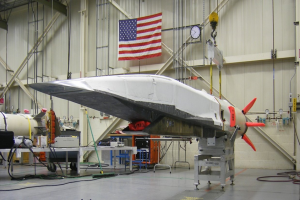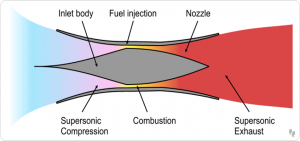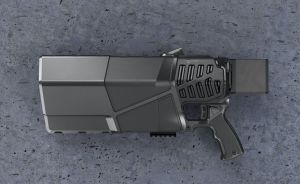Chapter 8: Emerging Interdiction Technologies
J.P. Hood
Student Learning Objectives
The student will obtain an understanding of how the technologies affecting C-UAS trends are changing and advancing at a rapid pace. Everything from crude yet refined kinetic systems, hypersonic vehicle deliverables and cyber enhanced technologies are being developed to counter UAS incursion into protected air space. The student must be able to grasp new ideas, understand and maintain current doctrine and ideologies while thinking dynamically in order to remain relevant in the C-UAS realm.
Hypersonic Threats
A hypersonic missile travels at speeds of Mach 5 and higher – five times faster than the speed of sound (3836 mph), which is around 1 mile per second. Some missiles, such as Russia’s Kh-47M2 Kinzhal air-launched ballistic missile, are allegedly capable of reaching Mach 10 speeds (7672 mph) and distances up to 1200 miles. (Bosbotinis, 2018)
A Hypersonic Cruise missile is a type of missile that reaches its target with the help of a high-speed jet engine that allows it to travel at extreme speeds, in excess of Mach-5. It is non-ballistic – the opposite of traditional Intercontinental Ballistic Missiles (ICBM) which utilizes gravitational forces to reach its target. (Bosbotinis, 2018)
When hypersonic missiles become operational, the gap between missile defense systems and missile offence will be huge. Simply put, there is no single operational missile defense system that is capable of intercepting a hypersonic missile. Hypersonic missile research and development remains at the classified level, however in recent months many governments have announced successful tests and future projects. (Bosbotinis, 2018)
Hypersonic missiles offer a number of advantages over subsonic and supersonic weapons, particularly with regard to the prosecution of time-critical targets (for example, mobile ballistic missile launchers), where the additional speed of a hypersonic weapon is valuable. It can also overcome the defenses of heavily defended targets (such as an aircraft carrier). The development and deployment of hypersonic weapon systems will provide states with significantly enhanced strike capabilities and potentially, the means to coerce. This will be the case where a major regional power, such as Russia, may seek to coerce a neighbor, leveraging the threat of hypersonic strikes against critical targets. As such, the proliferation of hypersonic capabilities to regional states could also be destabilizing, upsetting local balances of power. However, it could also strengthen deterrence. (Bosbotinis, 2018)
Figure 8-1: Boeing X-51 Hypersonic

Source: (Boyd, 2019)
Hypersonic technology comes from using a scramjet (supersonic combustion ramjet) which is a variant of a ramjet airbreathing jet engine in which combustion takes place in supersonic airflow. As in ramjets, a scramjet relies on high vehicle speed to compress the incoming air forcefully before combustion (hence ramjet), but whereas a ramjet decelerates the air to subsonic velocities before combustion, the airflow in a scramjet is supersonic throughout the entire engine. That allows the scramjet to operate efficiently at extremely high speeds. (Urzay, 2018)
Figure 8-2 Scramjet Engine Principles

Source: (Urzay, 2018)
Hypersonic Countermeasures
Although there are no current countermeasures in place, technologies such as directed energy weapons, particle beams and other non-kinetic weapons will be likely candidates for an effective defense against hypersonic missiles. “Hypersonic weapons reduce the time required to prosecute a target (especially compared to current subsonic cruise missiles), the warning time available to an adversary, and the time available for defensive systems to engage the incoming threat,” says Bosbotinis. Although hypersonic threats would pose a significant challenge to current surface-to-air and air-to-air missile systems, such systems would, particularly in the conventional precision strike role, require a robust intelligence, surveillance, target acquisition and reconnaissance (ISTAR) network. (Bosbotinis, 2018)
Directed Energy Weapons
As UAS systems continue to advance in speed and maneuverability, enabling to remain outside of the engagement envelopes of traditional air defense systems, directed energy weapons have become the go to for low, slow and small UAS defense. These systems range in size from man portable equipment sets to permanent fixed sites. These systems typically offer a more cost effective and much safer way to deter, deny and destroy small tactical UAS with in a protected area of operations / facility.
In the fall of 2019, The US Air Force (USAF) has received the first anti-unmanned aerial system (UAS) laser weapon system from Raytheon to tackle the threat of enemy drones. The high-energy laser weapon system features an advanced variant of Raytheon’s Multi-spectral Targeting System (MTS). It uses electro-optical / infrared sensors to detect and track enemy drones. Once the UAS is identified and targeted, the laser weapon system can engage the threat and neutralize it instantly. The technology involves a high-energy laser weapon system (HELWS) mounted on a small all-terrain vehicle. A single charge is enough for the HELWS to provide dozens of precise laser shots. Furthermore, the weapon system supports pairing with a generator on the field to provide a nearly infinite number of shots. (Media, 2019)
Figure 8-3: Raytheon Mobile High Energy Laser System

Source: (Raytheon, 2019)
The Raytheon company’s advanced high-power microwave and high-energy laser defeated dozens of drone targets in a U.S. Air Force demonstration at the White Sands Missile Range in New Mexico in the Spring of 2019. Airmen took control of both the microwave and laser systems after just one day’s training. They used an Xbox-style controller to direct the laser and a joystick to operate the high-power microwave in real-world scenarios at the U.S. Army White Sands Missile Range in New Mexico. The HEL system, paired with Raytheon’s Multi-spectral Targeting System of sensors, uses invisible beams of light. Mounted on a small, all-terrain, militarized vehicle, the system detects, identifies, tracks and engages drones. Raytheon’s HPM uses microwave energy to disrupt drone guidance systems. High-power microwave operators can focus the beam to bring down drone swarms. With a consistent power supply, an HPM system can provide virtually unlimited protection. (Raytheon, 2019)
On July 17th, 2019 a variant of the Marine Air Defense Integrated System (MADIS) family of counter drone systems, the Light Marine Air Defense Integrated System (LMADIS), in use by the USMC, downed an Iranian drone in the Persian Gulf, which flew within 1,000 yards of a US Navy Vessel. The LMADIS is the product of a rapid development effort by Ascent Vision Technologies (AVT), the USMC Ground Based Air Defense team, and other partner suppliers. (BiancaV, 2019)
Figure 8-4: Ascent Vision Technologies Marine Air Defense Integrated System (MADIS)

Source: (BiancaV, 2019)
The Drone Gun MkIII is a compact, lightweight drone countermeasure designed for one hand operation. The product provides a safe countermeasure against a wide range of drone models. It allows for a controlled management of drone payload such as explosives, with no damage to common drones models or surrounding environment due to the drones generally responding via a vertical controlled landing on the spot, or returning back to the starting point (assisting to track the operator), with an immediate cease of video back to the drone pilot. RF disruption activation will also interfere with any live video streaming, first person view (FPV), back to the remote controller halting the collection of video footage and intelligence by the drone operator. (Shield, 2019)
Figure 8-5: Drone Gun MKIII

Source: (Shield, 2019)
Extreme Long-Range Cannon
In 2017, the US Army established a collection of cross-functional teams (CFTs) aimed at rapidly pushing forward key technologies to advance the services’ next generation of capabilities. One of those teams was the Long-Range Precision Fires “pilot,” an effort to develop the next generation of Army artillery—including “deep fires,” an artillery capability that can strike at strategic targets well within an adversary’s defenses. These systems seek to achieve a range of 1,000 nautical miles or more. There’s strong incentive for the Army to succeed because an extreme-long-range gun could help deal with the difficulty posed by adversaries with advanced over-the-horizon radar, shore defenses, and air defense systems—such as the kind being put in place by China in the South China Sea. (Gallagher, 2019)
Cyber-Enabled IADS
Figure 8-6: Typical Layered Russian Air IADS

Source: (Col Joseph Speed, 2019)
In order to allow friendly aircraft to conduct missions and support joint air power operations across the spectrum of warfare – from peacekeeping to high-intensity conflicts – NATO has nurtured developments in the Suppression of Enemy Air Defense (SEAD) mission. However, the newest generation of complex and capable enemy air defense assets threatens to overwhelm NATO’s current SEAD abilities. (COL Speed USAF, 2018).
Over the last 20 years, potential adversaries of the Alliance have studied western military capabilities and have developed robust A2/AD capabilities in response. Examples are abundant and include threats such as the Russian SA-20 ‘Gargoyle’ and SA-21 ‘Growler’, the Chinese – built HQ-9, and the Dong-Feng 21. These capabilities are tailored to deny the ‘western way of war’ by precluding access to what is arguably the west’s most potent influencer – air power. (COL Speed USAF, 2018)
Additionally, many state and non-state actors have been creatively employing military and commercial technologies to develop a range of capabilities for symmetric, asymmetric, and hybrid military activities, including AD. The technological trends include the following: anti-stealth technology, hypersonic weapons, cyber warfare, and access to and/or denial of space capabilities, to name a few. For example, Russian long-range surface to air systems now employ radar with anti-stealth technologies such as the ‘NNIIRT 1L119 Nebo SVU/RLM-M Nebo M’ mobile VHF active electronically scanned array (AESA) radar. In the realm of hypersonic, the Russians have an air-launched missile, the ‘Dagger’, which can reach and maintain Mach 10. In addition, China is developing anti-satellite capabilities such as the ‘Dong Neng 2 & 3’ exo-atmospheric vehicles. Primarily, these are direct-ascent missiles designed to ram and destroy satellites. (COL Speed USAF, 2018)
Advances in computing power and digital signal processing are allowing for more capable AD radars. These systems employ advanced techniques to improve acquisition range and target size detection and possess increased resistance to electronic attack or deception. In addition, new ideas in electromagnetic spectrum management are allowing radar technology to become more passive than active, which significantly complicates locating and targeting such sites. For instance, Russia is developing passive coherent radar designed for stealthy detection of moving aerial, ground and above-water targets in the protected area of important facilities. While passive radar systems are already being employed in both ground and air platforms, they are normally used to locate platforms vice engage them. That being said, passive radars will likely be able to target and guide weapons against air threats soon, significantly complicating the SEAD mission.
Adversaries’ legacy systems of hierarchical data management and links are being replaced with multi-node, high-capacity, efficacy networks, contributing to highly resilient, redundant, and robust Command, Control, Communications, Computers, Intelligence, Surveillance and Reconnaissance (C4ISR) systems. The resiliency of future C4ISR may be augmented by space-based technologies – such as micro-satellite constellations – making an Integrated Air Defense System (IADS) even more effective and agile. In addition, it is quite possible that a nodular system might enable air defense systems to continue to support operations through ‘remote’ operations, even if some parts of the IADS are damaged or destroyed. A current example of this is Russia’s experimentation with multi-node quantum networks. In effect, suppressing or destroying local air defense assets, which are linked into a multi-node network, may not provide effective suppression of the enemy IADS. (COL Speed USAF, 2018)
The growing ability to operate systems remotely will not only increase range of detection but will also increase remote crew survivability. ‘Remoting’ operations and unmanned technologies may not only increase the survivability of an IADS, but they will likely extend its detection and targeting capabilities by hundreds of miles. For example, the advancements in space technology may extend the ‘remoting’ capabilities of an IADS to altitudes extending into space. The combination of the aforementioned activities may increase the passiveness of an IADS, deny its detection and targeting, and make it resilient to most SEAD activities. (COL Speed USAF, 2018)
Lastly, over the next twenty years very long-range surface-to-air weapons, with advanced seeker guidance, smart warheads, and new propulsion technologies, may be employed in enemy AD missions. In particular, Surface-to-Air Missile (SAM) engagement zones may be extended up to 500 km. One need look no further than the Russian S-500 next-generation SAM system to see the lethality of future AD. Disturbingly, this particular missile system could enter service as early as 2020. These new long-range weapons’ technologies may contribute to a highly mobile, flexible IADS when combined with increases in computing power and decreasing size of hardware and processors. (COL Speed USAF, 2018)
IADS of the future are becoming even more lethal, agile whole remaining difficult to detect on the battlefield. While the US will continue to remain the dominate force through the air and space, potential adversaries will most likely continue to heavily invest in ways to undermine advances in aerial capabilities. These AD systems have already become so advanced that the US military and other nations are re-looking long range kinetic means to counter them. Maintaining an adaptive and dynamic frame of mind will be crucial in identifying and ultimately defeating these emerging threats, ensuring continued success on the battlefields of the future.
Big Data and Artificial Intelligence Integration
Artificial Intelligence (AI) is the theory and development of computer systems able to perform tasks that normally require human intelligence, such as visual perception, speech recognition, decision-making, and translation between languages. Big data is the field that treats ways to analyze, systematically extract information from, or otherwise deal with data sets that are too large or complex to be dealt with by traditional data-processing applications.
The incorporation of Artificial Intelligence into defense strategies has already begun to transform NATO’s ISR and defense capabilities in regard to the assimilation and processing of data in order to effectively identify targets. Science and technology advancements are helping to shape both the requirements and solutions for new approaches in order to meet NATO capability needs.
These capabilities will ultimately enhance military decision-making and accelerate the acquisition of actionable intelligence. The focus was on the impact on the OODA (observe, orient, decide, act) loop. We can see major impacts from AI, machine learning and big data in the observe function in terms of being able collect and assimilate large amounts of data and then process that efficiently and effectively to identify potential targets. This then helps orient towards specific areas of interest or targets of interest that you are looking for through your ISR capabilities. (Bayley, 2018)
These techniques can also be used in a defensive manner as well. Enhanced systems can potentially be used to detect, track and decide whether or not to engage a threat based on stored data sets and pre-determined patterns. This could potentially remove humans from the decision-making process but at the same time could reduce the time required to engage faster moving, more technologically advanced threats.
Conclusions
C-UAS technologies are changing and advancing. Hypersonic missiles, Directed Energy weapons (also covered in Chapter 10), long- range cannons, mobile drone guns and Cyber -enabled IADS represent steps in the future of Counter-UAS countermeasures. Much of the research work on these fine weapons is classified, necessitating only a brief open source treatment by the authors about this subject.
References
Bayley, J. (2018). Transforming ISR Capabilities through AI, Machine Learning and Big Data: Insights from Dr. Thomas Killion, Chief Scientist, NATO. Retrieved from DefenceIQ.com: https://www.defenceiq.com/defence-technology/news/transforming-isr-capabilities-through-ai-machine-learning-and-big-data
BiancaV. (2019, July 22). ascentvision.com. Retrieved from AVT Products Down Iranian Drone: https://ascentvision.com/avt-products-down-iranian-drone/
Bosbotinis, J. (2018, August 28 ). Hypersonic Missiles: What Are They And Can They be Stopped. Retrieved from defenceiq.com: https://www.defenceiq.com/defence-technology/case-studies/hypersonic-missiles-what-are-they-and-can-they-be-stopped
Boyd, I. (2019, May 1). us-russia-china-race-to-develop-hypersonic-weapons. Retrieved from theconversation.com: https://theconversation.com/us-russia-china-race-to-develop-hypersonic-weapons-114694
Col Joseph Speed, &. L. (2019, japcc- journal 27). challenges-of-future-sead-operations. Retrieved from www.japcc.org: https://www.japcc.org/challenges-of-future-sead-operations/
COL Speed USAF, L. S. (2018). Joint Air Power Competence Centre. Retrieved from japcc.org: https://www.japcc.org/challenges-of-future-sead-operations/
Gallagher, S. (2019, October 15). Bringing in the big gun: Army paves way for strategic cannon. Retrieved from arstechnica.com: https://arstechnica.com/tech-policy/2019/10/army-aims-to-test-extreme-long-range-strategic-cannon/
Media, V. (2019, October 23). airforce-technology.com . Retrieved from Air Force Technology: https://www.airforce-technology.com/news/usaf-raytheon-counter-uas-laser-weapon-system/
Raytheon. (2019, September 25 ). raytheon.com. Retrieved from Defense at the Speed of Light: Directed Energy Systems Down Drones in USAF Demonstration: https://www.raytheon.com/news/feature/defense-speed-light
Shield, D. (2019). DroneShield.com. Retrieved from DroneGun MKIII: https://www.droneshield.com/dronegun-mkiii
Urzay, J. (2018). Supersonic Combustion in Air-Breathing Propulsions Systems for Hypersonic Flight. Annual Review of Fluid Mechanics , 50: 593-627.
Supplemental Readings
Russia Missile Threat A2AD (Jan 2017)
https://missilethreat.csis.org/russia-nato-a2ad-environment/
Counter-Hypersonic (Dec 2019)
https://missilethreat.csis.org/mda-reveals-new-hypersonic-defense-program/
Hypersonic Countermeasures (Dec 2019)
https://aviationweek.com/defense/rfp-reveals-main-thrust-us-counter-hypersonic-plan
USAF Man-portable service rifle jamming module (Area Denial)

